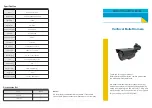
DROP CEILING INSTALLATION PROCEDURE
1.
Take off the drop ceiling from T-bar.
2.
Use CMP (B) as template to drill 5 holes on the
drop ceiling and cut a Ø35 mm to Ø38 mm
(Ø1.375" to Ø1.5") hole for BNC connector to
pass through (Fig. 6).
3.
From the local hardware store, purchase 5 sets
of M4 machine screw, M4 nut, and washer to
secure the CMP (B) to the drop ceiling.
4.
Follow step 3 to step 7 in Wall Mount
Installation Procedure for Camera Unit
installing.
Fig. 6
Top of drop ceiling
Room side of drop
ceiling
Drop Ceiling
CMP (B)
M4 Nuts (not included)
Washers (not included)
M4 Machine screw
(not included)
PAN/TILT/AZIMUTH ADJUSTMENT
Note: To watch the image adjustment, you may
connect the camera video output to a checking monitor.
However, the video output will be interrupted if this
check monitor does not have a loop through output.
Tatung’s 2.5” LCD Service Monitor TLM-0251i is an
ideal tool to be used to observe the image adjustment
while keeping the video signal continuity. Because
TLM-0251i not only has both BNC input and BNC
loop through output, but also has 75
Ω
automatic
termination.
1.
Connect a monitor as a checking monitor to the
BNC video output.
2.
Aim the camera towards the object by adjusting
the pan, tilt and azimuth angle of the camera.
The camera can be rotated as shown in Fig 7.
Fig. 7
3.
Disconnect the checking monitor and restore
the video connection of the camera video
output.
4























